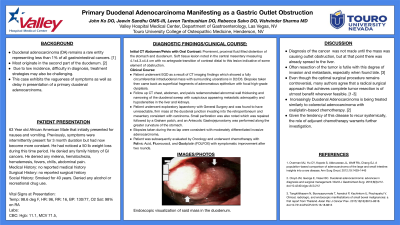Tuesday Poster Session
Category: Small Intestine
P4124 - Primary Duodenal Adenocarcinoma Manifesting as Gastric Outlet Obstruction
Tuesday, October 24, 2023
10:30 AM - 4:00 PM PT
Location: Exhibit Hall

Has Audio

John Ko, DO
Valley Hospital Medical Center
Las Vegas, NV
Presenting Author(s)
John Ko, DO1, Rebecca Salvo, DO1, Vishvinder Sharma, MD1, Levon Tantoushian, DO1, Jeevin Sandhu, 2
1Valley Hospital Medical Center, Las Vegas, NV; 2Tour University Nevada, Henderson, NV
Introduction: Duodenal adenocarcinoma (DA) remains a rare entity representing less than 1% of all gastrointestinal cancers. Most originate in the second part of the duodenum. Due to low incidence, difficulty in diagnosis, treatment strategies may also be challenging. This case exhibits the vagueness of symptoms as well as delay in presentation of a primary duodenal adenocarcinoma.
Case Description/Methods: 63-year-old male presented to our hospital for nausea and bilious vomiting. His symptoms began 4 months prior with episodes usually lasting a few days but progressively worsened and caused an associated 50lb weight loss. Labs showed a microcytic anemia with Hgb 9.8 and MCV 71. CT abdomen with oral contrast showed a mesenteric soft tissue lesion with associated compression of bowel. There was proximal dilation of the duodenum and stomach indicating some obstruction. Given these findings, he underwent EGD which noted a circumferential intraduodenal mass with surrounding ulceration in D2/D3. Biopsies noted adenomatous epithelium with high grade dysplasia. Follow up CT chest, abdomen and pelvis redemonstrated abnormal wall thickening and narrowing of the duodenal sweep or proximal 4th portion of the duodenum with suspicious appearing metastatic adenopathy and tiny hypodensities in the liver and kidney. He underwent exploratory laparotomy which found an unresectable, firm mass at the duodenojejunal junction invading into the retroperitoneum and mesentery consistent with carcinoma. There was a small perforation noted which was repaired followed by a Graham patch, and an Antecolic gastrojejunostomy was performed along the greater curvature of the stomach. A metastatic lesion was also found in the liver. Biopsies were consistent with invasive adenocarcinoma. As the mass was deemed unresectable, he was evaluated by oncology and underwent chemotherapy treatments with FOLFOX. After 2 rounds, his symptoms improved.
Discussion: Diagnosis was not made until the mass was causing outlet obstruction, but there were already metastases to the liver. Often resection of the tumor is futile at this point. Even though the optimal surgical procedure remains controversial, many agree that a radical surgical approach that achieves complete tumor resection is of utmost benefit whenever feasible. Recently, DA is being treated similarly to colorectal adenocarcinoma with oxaliplatin-based chemotherapy. Given the tendency of this disease to recur systemically, the role of adjuvant chemotherapy warrants further investigation.
Disclosures:
John Ko, DO1, Rebecca Salvo, DO1, Vishvinder Sharma, MD1, Levon Tantoushian, DO1, Jeevin Sandhu, 2. P4124 - Primary Duodenal Adenocarcinoma Manifesting as Gastric Outlet Obstruction, ACG 2023 Annual Scientific Meeting Abstracts. Vancouver, BC, Canada: American College of Gastroenterology.
1Valley Hospital Medical Center, Las Vegas, NV; 2Tour University Nevada, Henderson, NV
Introduction: Duodenal adenocarcinoma (DA) remains a rare entity representing less than 1% of all gastrointestinal cancers. Most originate in the second part of the duodenum. Due to low incidence, difficulty in diagnosis, treatment strategies may also be challenging. This case exhibits the vagueness of symptoms as well as delay in presentation of a primary duodenal adenocarcinoma.
Case Description/Methods: 63-year-old male presented to our hospital for nausea and bilious vomiting. His symptoms began 4 months prior with episodes usually lasting a few days but progressively worsened and caused an associated 50lb weight loss. Labs showed a microcytic anemia with Hgb 9.8 and MCV 71. CT abdomen with oral contrast showed a mesenteric soft tissue lesion with associated compression of bowel. There was proximal dilation of the duodenum and stomach indicating some obstruction. Given these findings, he underwent EGD which noted a circumferential intraduodenal mass with surrounding ulceration in D2/D3. Biopsies noted adenomatous epithelium with high grade dysplasia. Follow up CT chest, abdomen and pelvis redemonstrated abnormal wall thickening and narrowing of the duodenal sweep or proximal 4th portion of the duodenum with suspicious appearing metastatic adenopathy and tiny hypodensities in the liver and kidney. He underwent exploratory laparotomy which found an unresectable, firm mass at the duodenojejunal junction invading into the retroperitoneum and mesentery consistent with carcinoma. There was a small perforation noted which was repaired followed by a Graham patch, and an Antecolic gastrojejunostomy was performed along the greater curvature of the stomach. A metastatic lesion was also found in the liver. Biopsies were consistent with invasive adenocarcinoma. As the mass was deemed unresectable, he was evaluated by oncology and underwent chemotherapy treatments with FOLFOX. After 2 rounds, his symptoms improved.
Discussion: Diagnosis was not made until the mass was causing outlet obstruction, but there were already metastases to the liver. Often resection of the tumor is futile at this point. Even though the optimal surgical procedure remains controversial, many agree that a radical surgical approach that achieves complete tumor resection is of utmost benefit whenever feasible. Recently, DA is being treated similarly to colorectal adenocarcinoma with oxaliplatin-based chemotherapy. Given the tendency of this disease to recur systemically, the role of adjuvant chemotherapy warrants further investigation.
Disclosures:
John Ko indicated no relevant financial relationships.
Rebecca Salvo indicated no relevant financial relationships.
Vishvinder Sharma indicated no relevant financial relationships.
Levon Tantoushian indicated no relevant financial relationships.
Jeevin Sandhu indicated no relevant financial relationships.
John Ko, DO1, Rebecca Salvo, DO1, Vishvinder Sharma, MD1, Levon Tantoushian, DO1, Jeevin Sandhu, 2. P4124 - Primary Duodenal Adenocarcinoma Manifesting as Gastric Outlet Obstruction, ACG 2023 Annual Scientific Meeting Abstracts. Vancouver, BC, Canada: American College of Gastroenterology.
